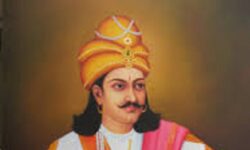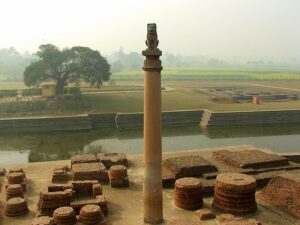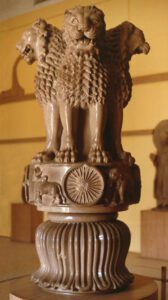Ashoka the emperor who gave up war
Ashoka was the great emperor of Mauryan Dynasty who gave up the war under the influence of Buddhism. He was the third Mauryan emperor who ruled almost all of the Indian subcontinent. He was the grandson of the Mauryan dynasty founder, Chandragupta Maurya. Ashoka was one of India’s greatest emperors and a big supporter of Buddhism. Ashoka is always known to be connected with 2 importants events in his life, one of them is Karuvaki and another is his the history of Takshashila.

After executing a very destructive war against the state of Kalinga in 260 BCE he converted himself to Buddhism. Ashoka is known for his pillars and edicts, for sending Buddhist monks to Sri Lanka and central Asia and for creating monuments and sites describing the life of Gautam Buddha.
Quick Facts
- Full Name: Ashoka
- Born: 304 BCE
- Died: 232 BCE
- Religion: Buddhism
- Spouse: Karuvaki, Tishyaraksha, Padmavati, Asandhimitra, Devi
- Father: Bindusara
- Mother: Subhadrangi
- Famous as: 3rd Mauryan Emperor
Early life
Ashoka’s mother gave him the name “Ashoka” which means without sorrows. As per Ashokavadana, Ashoka’s mother was the daughter of a brahmin family from Champa. As per Ashokavadana Bindusara, his father didn’t like Ashoka because of his ugly looks and rough skin. But he still offered him equally important responsibilities in comparison to other princes. Because Bindusara had faith in his abilities.
Later Life
Ashoka married to Devi whose father was a tradesman. During that time Bindusara appointed Ashoka as the governor of Avanti. He had 2 children with his first wife. Ashoka became a great warrior as he grew up. He also had a great control on Mauryan army.
When Bindusara appointed Ashoka in Kalinga, he fell in love with Karuvaki who was a fisherwoman. He married to her. At the same time, violence started in Ujjain. So Ashoka returned to Ujjain. He injured badly. Buddhist monks treated him. This was the time when he came to know deeply about the life of Buddha.
After his father’s death, Ashoka attacked Pataliputra. He killed all of his brothers except his younger brother Vitashoka. Ashoka was a cruel ruler as per Ashokavadana. After the huge violence and destruction in the Kalinga war he moved towards Buddhism. He converted into Buddhism after facing the sufferings caused by the Kalinga war.
History behind Ashoka at Takshashila
As per Ashokavadana, Bindusara appointment Ashoka in Takshashila to end a rebellion. Bindusara provided him with a huge army but didn’t offer him any weapon. Citizens of Takshashila welcomed Ashoka. And they told him that their enemy is not the king but the evil ministers. Takshashila was very well connected to Pataliputra. It was the Mauryan capital at that time. However, there is no such record which proves that Ashoka had ever visited Takshashila for rebellion. But there is an Aramaic language inscription mentioned in an archeological site namely Sirkap in Taxila. This site supports the evidence of Ashoka’s rebellion at Takshashila.
Governor of Ujjain
As per Mahavamsa, Bindusara had appointed Ashoka as Viceroy of Ujjain. It was an important and commercial centre in Avanti province. There is an inscription namely Saru Maru found in central India. It is the evidence of Ashoka’s visit to Ujjain as a Prince. But as per Ashoka’s rock edict, he had visited and served Ujjain as Viceroy during his rule.
As per Sri Lankan tradition, he visited Vidisha which is a city in Madhya Pradesh nowadays. There he fell in love with Devi and married to her. Ashoka had 2 children from Devi. He had a son named Mahinda and a daughter named Sanghamitta in Ujjain.
Ascension to the throne
Ashoka’s ascension to the throne was a challenging one. As per Ashokavadana, Ashoka’s eldest brother Susima had once slapped a bald minister on his head jokingly. That minister was very hurt with this behavior. In a reply to this, he convinced 500 ministers to support Ashoka’s ascension to the throne. Sometimes later, Bindusara sent Susima to Takshashila to suppress the rebellion. Susima was unsuccessful to end the rebellion at Takshashila. Suddenly Bindusara fell ill and was about to die. Bindusara called him back and ordered him to control the situation in Takshashila. Though Ashoka was ill, still he able to suppress the rebellion in Takshashila. As a result, Bindusara crowned him as the next king. After his father’s death Ashoka rosed as a powerful king. Ashoka extended his authority to the entire world including Naga and Yaksha territory.
Kalinga war
Kalinga war was the major war he fought in his lifetime. This was the war between king Ashoka and king Anantha of the state Kalinga. Kalinga state is nowadays Odisha and some Northern parts of Andhra Pradesh. Kalinga war is one of the bloodiest wars in the indian history. Though Ashoka conquered Kalinga state but this war was so destructive that it changed his mind against wars. Additionally, he moved towards Buddhism.
Conversation to Buddhism
It is said that earlier he was a cruel king before the conversion to Buddhism. Ashoka changed himself completely after he converted to Buddhism. He also changed the way of his ruling because under the influence of Buddhism.
Ashoka made 84000 stupas or viharas to preserve the Buddha objects. He had collected 7 seven relics of Gautam Buddha. Some writers have mentioned that Ashoka had sufferings caused in the Kalinga war. As a result, he converted to Buddhism. Whereas some of the writers have claimed that he was already a Buddhist before the war.
Achievements
- Indian flag has his “Ashoka Chakra”.
- Ashoka built 84000 stupas in order to preserve the objects of Buddha.
- He created many meditation places in Asia for Buddhist monks.
- Erection of Pillars of Ashoka in almost all of the places including Mauryan Empire Nepal etc.
- Sarnath museum has the Lion Capital of Ashoka with the four lions standing back to back.


Edicts
- Dharma is charity, truthfulness, mercy, purity and doing good for humanity. Ashoka used his power to make people’s life better.
- Ashoka always made a fair justice for his prisoners and pardon them very often.
- He had respect for the animals. So he had strictly prohibited killing wild animals.
- Ashoka had a strong belief in Buddhism. Thus he became the great follower of Buddha’s teachings later in his life.
- He had the same respect for all the religions. He had a belief that all religions share the common and positive essence.
- Ashoka took great initiative in improving the roadside facilities for travellers comfort. For example he ordered to plant banyan trees on the roads to offer shade to the travellers.
Death
Ashoka died around 232 BCE. As per Ashokavadana, Ashoka died because of his severe illness during his last days. It is said that his body burned for seven days and nights during cremation.
Pingback: what does Buddhism mean - Fourth Largest religion in the world
Valuable info. Lucky me I found your website by accident, and I am shocked why this accident did not happened earlier! I bookmarked it.